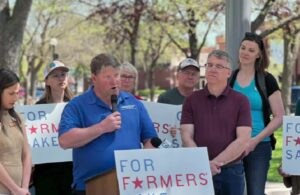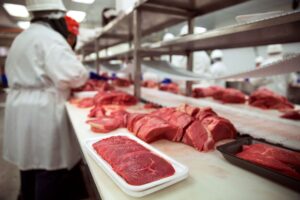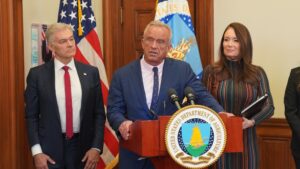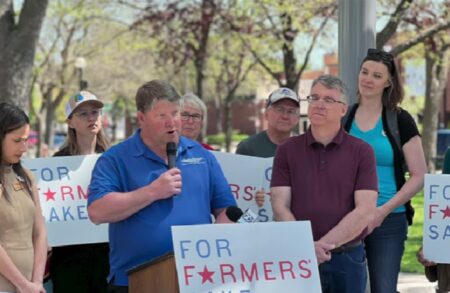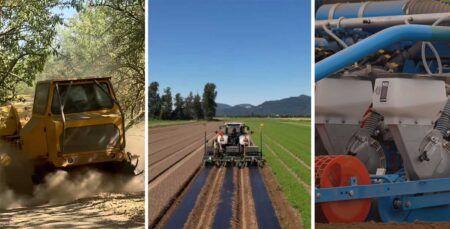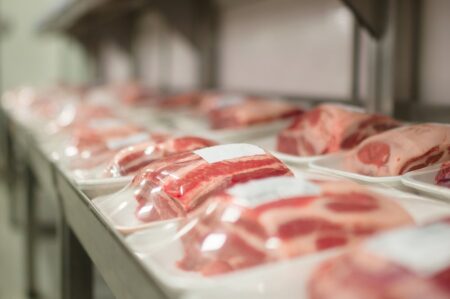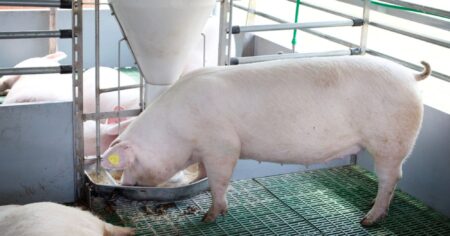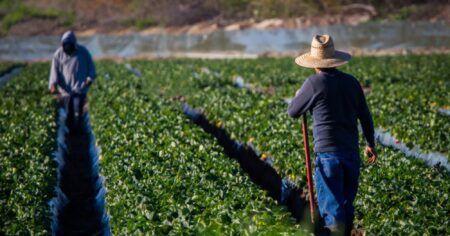By Cami Koons
U.S. Sen. Chuck Grassley called for the end of countervailing duties on phosphate fertilizer during a Senate committee hearing Tuesday on competition in fertilizer and seed industries.
Farmers, retailers and politicians from both sides of the aisle agreed that consolidation in the agricultural industry is making it more difficult for farmers to make ends meet, especially when they are also faced with global trade opposition.
Grassley, chair of the U.S. Senate Committee on the Judiciary, said farmers “don’t have a real choice, let alone a fair price” in the seed and fertilizer industries.
Grassley said one solution would be to pass the Fertilizer Research Act he proposed with Sen. Joni Ernst, also a Republican from Iowa, and Sen. Tammy Baldwin, D-Wis. The bill would require the U.S. Department of Agriculture to conduct a study on competition and pricing in the fertilizer industry.
“Nobody here wants to punish innovation,” Grassley said. “We want better yields, healthier soils, quality products, and we’ve been vastly improving in that area for the last 40 years. But we also want competition that’s fair, transparent and local competition that a farmer can actually express when he or she sits down to make a purchase.”
While the hearing focused on consolidation in the seed, fertilizer and pesticide industries, Grassley said the Trump administration could do something “right now” to ease the burden on farmers by lowering the import tariffs imposed on Moroccan phosphate.
These tariffs were raised in 2024 during the Biden administration. Grassley said the tariffs on the key farming inputs have “hurt farmers.”
“I’m calling on the Trump administration to help American farmers and get rid of that phosphate duty,” Grassley said.
Sen. Cory Booker, a Democratic committee member from New Jersey, said farmers are in a “crisis” that has led to “a loss of American family farmers in a way that could be described as an extinction-level event.”
Booker said the commercial seed industry has prohibited farmers from the “fundamental right” of saving seeds. He said the consolidated industry instead locks them into buying “patented seeds” that are “bundled with their own pesticides by corporations.”
“This is corporate capture of the very first link in our food chain, and when you control the seed, you have unjust control over farmers, and ultimately you control the food,” Booker said.
Seeds are often modified to be resistant to certain pesticides. For example, “Roundup ready” seeds, produced by Monsanto, now Bayer, were resistant to the herbicide Roundup, which Bayer also manufactures. The product allowed farmers to plant a crop and spray for weed without harming the crop. It also meant that farmers bought both seeds and pesticides from the company.
Consolidation
According to Diana Moss, the vice president and director of competition policy for the Progressive Policy Institute, who spoke as a panelist at the hearing, seed and fertilizer markets are consolidated to just a few big players.
A USDA study on concentration in the agricultural marketplace found that from 2018-2020, two seed companies accounted for 72% of planted corn acres and 66% of planted soybean acres. A Texas A&M University study found that the four-firm concentration for nitrogen fertilizer in the U.S. was 77%, while potash and phosphate fertilizer markets are 100% controlled by the top four companies.
“These are big numbers,” Moss said. “Highly concentrated markets are far more conducive to anticompetitive coordination, rather than the hard-nosed competition that lowers prices, lowers licensing fees, tech fees and royalty rates.”
Moss said “all of this puts the squeeze on farmers’ margins” and said the role of antitrust laws has been “less than exemplary” in regulating ag biotech.
Iowa farmers like Noah Coppess, another panelist at hearing, are feeling that squeeze. Coppess said phosphate, for example, has become a “bare minimum usage” fertilizer on his farm. The fertilizer is so costly, it’s close to a negative return on Coppess’ farm.
Coppess has implemented tools like advanced tractor imaging that helps to reduce the use of fertilizer and pesticide inputs by specifically targeting the areas of a field that need it most. But, he said, that same technology charges him a usage fee on the fields that he doesn’t use it on, which almost equates to what he saves in inputs.
Coppess said the consolidation in the seed market has meant his farm has planted the same soybean variety for the past five years, “due to lack of competitive options.”
“It’s time to take a look into these areas and assess what bargaining strength the farmer has,” Coppess said.
The U.S. accounts for less than 10% of total global fertilizer production, according to USDA data.
Corey Rosenbusch, president of The Fertilizer Institute, said “fertilizer is a globally traded commodity subject to fierce global competition and supply and demand.”
Rosenbusch went on to say the nature of the fertilizer market, and the U.S.’s small role in production, means that current geopolitics create difficulties and high costs for importing fertilizer. At the same time, he said demand for fertilizer has increased as crops, like corn, which have a high fertilizer demand, have been planted more.
“We recognize how challenging and frustrating that this must be for our customer partners at a time when they’re experiencing very low prices for the crops that they grow,” Rosenbusch said.
He said while the fertilizer industry cannot “directly influence prices” of a globally traded commodity, a bolstered domestic fertilizer supply would help U.S. farmers.
John Latham, president of Latham Hi-Tech Seeds, an independent seed company in Alexander, Iowa, said operations like his have been priced out of the market by the big seed companies.
Latham said seed technology costs are increasing not just on the “newest and latest” seed technologies, but also on older seed technologies, some of which have already come off of their patents.
Latham said the seed royalties, or the amount a seller has to pay for the seed technology, has increased significantly over the past five years. According to Latham, about 70% of the cost of a seed bag goes to royalties now, compared to 42% of the bag five years prior.
“Imagine being in a business where the technology royalty continues to increase even after it goes off patent, seed prices increase even when commodity prices are low and farmers can’t even break even,” Latham said. “These are the unfortunate realities of an independent seed company in an industry without competition or oversight.”
Seed companies research and create seeds that will be resistant to certain pesticides, or be more resilient to pests like soybean cyst nematodes or plant diseases.
Andrew LaVigne, president and CEO of the American Seed Trade Association, said plant breeding and seed creation can take close to a decade.
LaVigne said through this process, a seed may cross six or seven different borders, and be subject to individual tariffs, before it makes it to a farmer. He said this increases the cost and time it takes to bring new seed technology to the market.
He suggested Congress reform some regulations to ensure the “rapid pace of scientific innovation is not hampered.” LaVigne also said increased investment in agricultural research at land grant institutions and other research institutions would help lower the costs of seed technologies.
“We know that farmers are taking this economic challenge head on to continue feeding, fueling and clothing the world,” LaVigne said. “Seed producers are weathering it alongside them while working to deliver the high quality, professionally produced seed U.S. farmers expect, season after season.”
High Inputs Alongside Trade Disruptions
Sen. Dick Durbin, D-Illinois, ranking member on the committee, spoke about the “overall state of the farm economy” as China turns away from the U.S. and instead to Brazil and Argentina for soybeans in response to U.S. tariffs.
Durbin said China is “playing the long game at the expense of American farmers” at the same time that farmers are grappling with the increasing cost of doing business.
“All farmers need help but no amount of financial relief can replace lost markets, especially if relief payments simply go from farmers straight to the handful of seed, fertilizer and equipment companies,” Durbin said.
Durbin said to Rosenbusch during questioning that the prices in the consolidated fertilizer industry are “killing” farmers.
“We need the farmers to succeed,” Rosenbusch responded. “They need access to fertilizer and those are all driven by global supply and demand. A lot of these geopolitical events and reliance on some of that foreign supply coming in has a huge impact on that.”
American Soybean Association President Caleb Ragland said the significant challenges facing agriculture are evident by farmers’ “rapidly plunging margins.”
“The high cost of farm production has eroded the financial safety net of soybean farmers and has made it harder to weather trade related market losses this year,” Ragland said.
Ragland called for finalization of key renewable fuel tax credits, which the industry believes will help boost domestic soybean demand, and for the removal of tariffs with China that are currently impacting soybean farmers’ largest market.
President Donald Trump has said he expects to reach a trade agreement with Chinese leader Xi Jinping on Thursday. The agreement is expected to include trade deals for soybeans, among other agricultural commodities.
Iowa Capital Dispatch is part of States Newsroom, a network of news bureaus supported by grants and a coalition of donors as a 501c(3) public charity. Iowa Capital Dispatch maintains editorial independence. Contact Editor Kathie Obradovich for questions: [email protected]. Follow Iowa Capital Dispatch on Facebook and Twitter.


